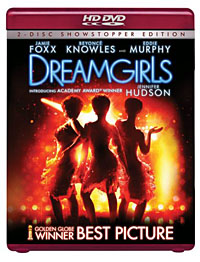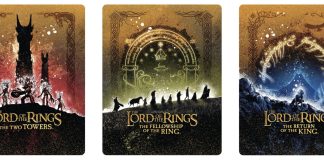As to Mr. Gates’ remarks, he tends to look out further, and see this as the last optical format. Nobody disagrees. But Microsoft sees HD-DVD as a five to seven year format. The Blu-Ray folks are talking a 10-to-15 year time frame and investment, which suggests how much longer they need to get their money back. And while these may be the last optical discs, they’re not going to be the last packaged media. Toshiba has already announced a 200 GB flash memory (editor: equaling the largest capacity announced for a two sided Blu-Ray disc.)
 |
Q: Yes, but at what price for a card – $1,000?
Graffeo: The prices are already dropping very fast on flash memory. In the next five years, you’ll see it down there at a price affordable to be used for packaged media.
Q: What about the cost of duplication, HD-DVD versus Blu-Ray?
Graffeo: Another advantage for HD-DVD. While all the focus has been on the North American group of studios, where subsidized prices for disc duplication have been at play, a more accurate picture emerges in Europe. I also manage the global side of our business. In Europe, the software leader is HD-DVD. 35 content providers, from Canal Plus on down, have signed up to produce in HD-DVD exclusively because the duplication is so much more affordable. It’s easy to convert a standard DVD line to do HD-DVD. With Blu-Ray, you have to start over from scratch, build a whole new line, and the Blu-Ray camp is very guarded with its technology. It’s a closed system. At the moment, in the States, if you want a 50GB Blu-Ray disc, you have to deal with Sony. It’s got the only production line, and I hear it’s pressed to the limits.
Q: That leads me into the next question. According to Nielsen sales figures, Blu-Ray software has been greatly outselling HD-DVD this year. Like 3 to 1. How do you respond to that?
Graffeo: This is a new release business. You have certain studios that only had six movies in the first quarter on HD-DVD and none were huge blockbusters, On Blu-Ray they had 16 movies with some big successes, like “Casino Royale.” . When you have a population of 100,000 players you’re not going to have a big business in catalogue titles yet, so you have to give that area some time. When you look at total sales to date, the two formats are almost even. And the attach rate to HD-DVD players is 28 to 30 titles in the first year. The Blu-Ray camp keeps talking about how those million plus Play station 3 customers are interested in watching high def movies, but the attach rate there is less than one Blu-Ray disc to a player – and the first couple hundred thousand came with a free movie. So the customer for that machine is really a game player.
For us, April was when everything really started coming together. You know, Circuit City, the second biggest retailer in the country, didn’t sell any Toshiba products until January. Now they’re selling the brand’s flat screen TVs and HD-DVD players. Best Buy has been very pro Blu-Ray, for some reason. But now we’ve educating the retailers, the merchandizing is hitting its stride in the store, the TV campaign’s out there. The price for the player is down to the impulse purchase point. In the fourth quarter, there will be a lot of hot movies, transfers of the summer theatrical releases, in the format. And already, you’re seeing films on HD-DVD pushing the interactive, technical envelope. Warner Bros. , even though they’re neutral, is putting titles out first or more fully featured on HD-DVD, like “Batman Begins,” the “Matrix” box sets and “Blood Diamond,” their first to have on-line connectivity.
At our studio, I’ve seen amazing growth in interactive content in just three months from what we did with “Bourne Supremacy” to what we did with “Miami Vice.” One that will be really great is the first season of “Heroes,” coming out on HD-DVD August 28. In terms of on-line interactive content, it will be awesome, a showcase. There’s a lot involved in having an on-line connected title. It’s development of the server, having consistency in branding, how the registration is done by the consumer. We don’t just want to run out with something and it’s not terrific, although the beauty of on-line delivered content for a film is that it can be refreshed, added to, later on.
Q: Clearly, both camps are subsidizing the real costs of their players, by several hundred dollars per unit, I hear, to build market share. What’s to prevent the Blu-Ray camp from dropping their prices to match HD-DVDs?
Graffeo: They can drop their price, but will never be able to compete with HD-DVD, with its $299 list price product in the fourth quarter, unless it’s with some left over stock of first generation Blu-Ray players. Their lead dog is the PS3. It’s likely to have a price drop, but it won’t get below $499, because the cost of the component parts is higher. While both formats use blue lasers, the pickup spec for HD-DVD has a much higher tolerance for error. For Blue-Ray, because its disc pits are narrower, the spec for the pickup is much less forgiving, which requires a more costly manufacturing process. I can’t comment on if Toshiba is losing money on players, but I will say Toshiba is one of the few Japanese companies that goes across the manufacturing spectrum in terms of products and component parts. It’s also a giant in the PC business. By the end of 2007, you’ll see many more PCs from Toshiba with HD-DVD drives, as well as from Acer, Gateway and others, brands that represent 70 percent of the global market.
Q: Okay, so here’s the billion dollar question that many people speculate about. Does Universal have a financial interest, maybe an on-going royalty incentive, to remain loyal to HD-DVD?
Graffeo: I can’t comment on that. But you could ask the same question to Disney and Fox, regarding their ties to Blu-Ray. Ask them, why are you so insistent on being in just the Blu-Ray camp? What is so great about Blu-Ray? I still have a hard time answering that.
Source: AllthingsHiDef.com












